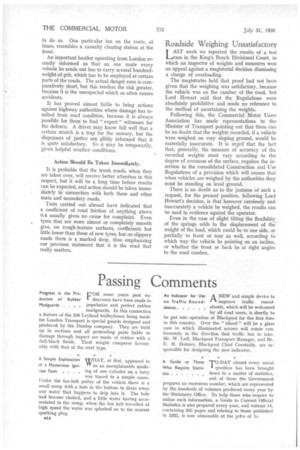Passing Comments
Page 20

Page 21

If you've noticed an error in this article please click here to report it so we can fix it.
Progress in the ProOR some years past en duction of Rubber deavours have been made to Mudguards . . . popularize and perfect rubber
mudguards. In this connection a feature of the 100 Leyland trolleybuses being made for London Transport is special guards designed and produced by the Dunlop company. They are built up in sections and all protruding parts liable to damage through impact are made of rubber with a dull-black finish. Their weight compares favourably with that of the steel type.
A Simple Explanation WHAT. at first, appeared to of a Mysterious !gniYV be an unexplainable misfit.
:ion Fault . . . ing of one cylinder on a lorry was traced to a simple cause. Under the fan-belt pulley, of the vehicle there is a small sump with a hole in the bottom to drain away any water that happens to drip into it. The hole had become choked, and a little water having accumulated in the sump, when the fan belt travelled at high speed the water was splashed on to the nearest sparking plug.
B14
ANEW and simple device to improve traffic roundabouts, which will be welcomed by all road users, is shortly to be put into operation at Blackpool for the first time in this country. Over the " island " will be a glass case in which illuminated arrows will rotate continuously in the direction that traffic has to take. Mr. W. Luff, Blackpool Transport Manager, and Mr. E. H. Holmes, Blackpool Chief Constable, are responsible for designing the new indicator.
An Indicator for Use on Traffic Round abouts
TO-DAY almost every social 1. question has been brought down to a matter of statistics, and of these the Government prepares an enormous number, which are represented by the hundreds of volumes produced every year by the Stationery Office. To help those who require to utilize such information, a Guide to Current Official Statistics is also prepared every year, and volume 14, containing 365 pages and relating to those published in 1035, is now obtainable at the prite of 1s. A Guide to These Who Require Statistics.. Automobile AssociaTHE Automobile Associa
tion Completely Retion, which, as is well vises Road Itineraries. known, supplies particularly
useful road itineraries, has spent two years in bringing this service up to date. The wark has involved the printing of 12,000,000 new sheets on 12 tons of paper, and the drawing of over 8.,000 sketch maps, whilst the series of toWn plans has' been increased by 50 per cent. Intermediate mileages, formerly shown side by side with route directions, are now also indicated on the sketch snap of the road traversed. Specially equipped logging .cars have covered over 50,000 miles during the past 18 months in checking gradients, road numbers, etc.
Progress of CommerINTERESTING figures concial-vehicte Production 1 cerning the growth of the
in Germany • . motor industry in Germany are
contained in the comprehensive report on that country's economic conditions, prepared by the Commercial Counsellor to the British Embassy at Berlin. The production of goods vehicles rose from 25,681 in 1934, to 38,851 in 1935, and motorbuses from 1,641 to 2,645 respectively. Curi
ously enough, the trend is in the direction of heavier vehicles; the percentage of these rose from 11 in 1932 to 20 in 1935, whilst that of lorries between 1-ton and 3-tons fell off slightly and: the proportion of 1-tonners remained at about 25 per cent. The registrations of lorries and special vehicles in ,1931 rose by 94 per cent., and of buses hy 117 per :cent., whilst over 6,000 tractors were registered for the first time. Over 20,000 trailers were sold in 1935, against 11,000 in 1934. The increase in the heavier classes is probably due to the influence of the new German roads.
An EfficientFiling n URING a visit from a System Used by the I-1 road transport operator in . • . . Southern Rhodesia he expressed appreciation of the efficiency of the London County Council Licensing Department. On applying for a driving licence he mentioned that he had had one in 1920. This was checked up within a minute or two. Asked whether he had been " keeping his hand in," he was able to reply that, until recently, he had been driving 40,000 to 50,000 miles a year.












































































